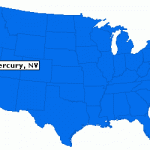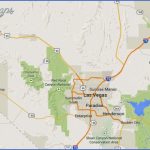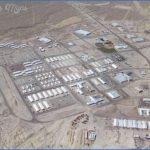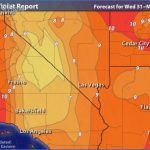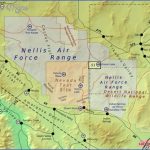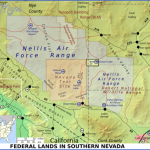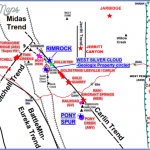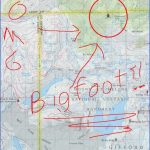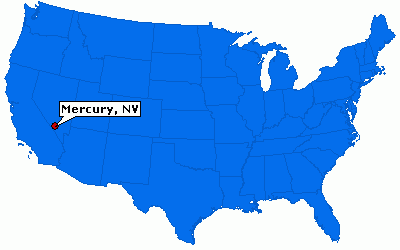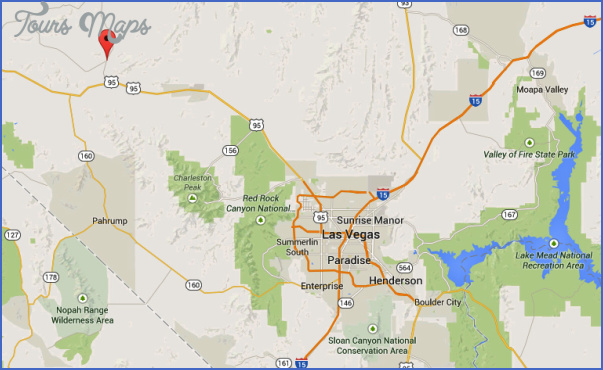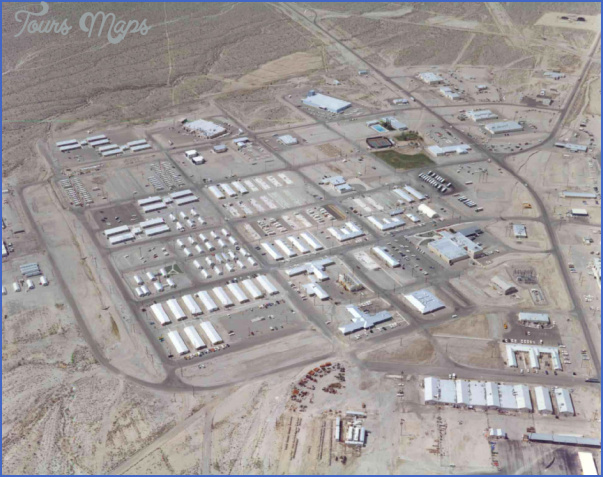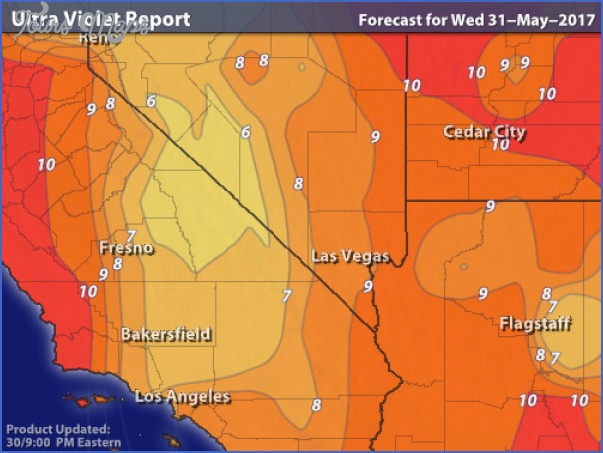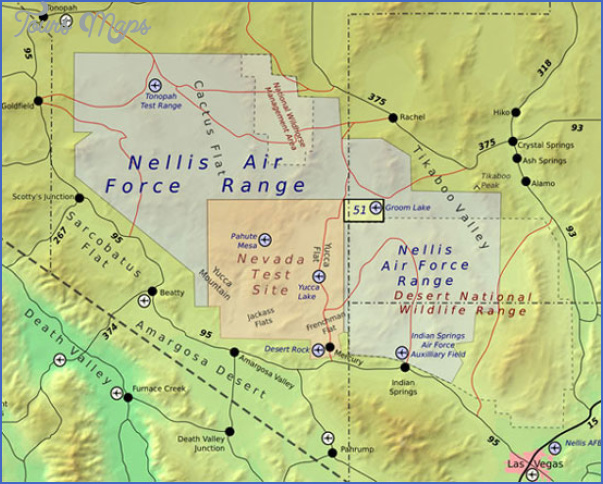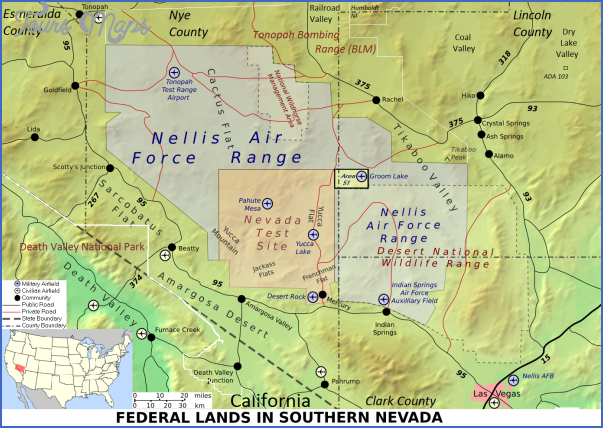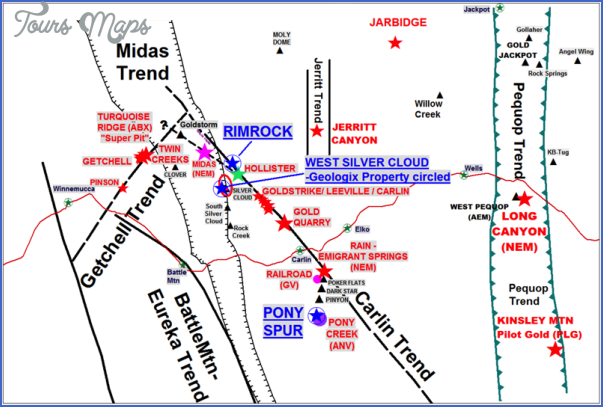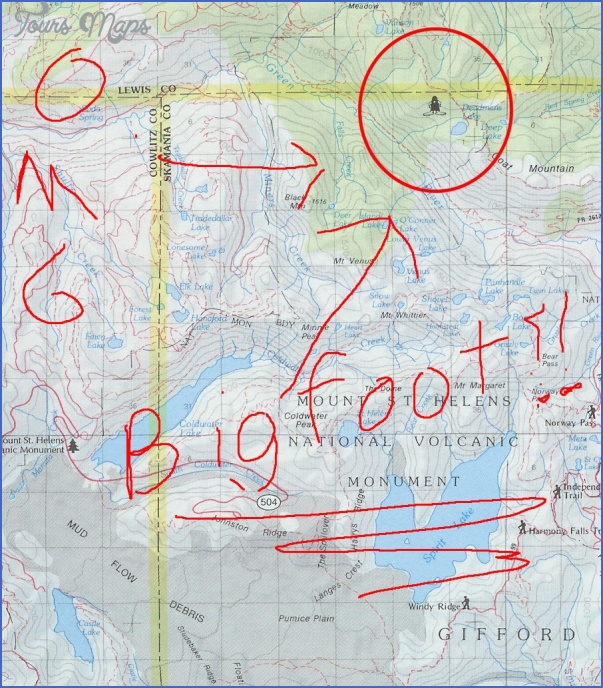Nevada Test Site (NTS) Mercury
Located about 65 miles north of Las Vegas is the most heavily-nuked piece of real estate on this planet. But in 1992 a moratorium on nuclear testing went into effect. So what do you do with a chunk of land bigger than Rhode Island (site #3 in Top Secret America) that has blast craters like those on the moon and areas of high radioactivity if you can’t test atomic bombs there? Well, you do hazardous chemical spill tests, “environmental technology studies,” “emergency response training, ” and build a germ “factory” to produce microbes for germ warfare research. Plus you also turn it into a prime Top Secret Tourism destination by offering guided tours!
The Department of Energy describes the Nevada Test Site (NTS) as “a unique national resource.”
The NTS was established in December 1950, and occupies over 1,350 square miles. Its eastern boundary is Area 51, making their combined area among the most secretive and closely guarded pieces of real estate on this planet. Between 1951 and 1962, 126 atomic bomb tests were conducted aboveground within the confines of the NTS. In that era, a highlight for many vacationers to Las Vegas was not seeing Frank, Dean, or Sammy at The Sands, but instead driving up north on Highway 95 to see a real, live atomic bomb explosion. Atmospheric nuclear testing was banned by international treaty in 1962. Underground tests were still permitted, and over 800 were conducted here until 1992. Since then, underground “subcritical” tests have been conducted here that use amounts of fissionable material too small to sustain a chain reaction.
All these tests have left NTS “hot.” According to a report in the October 23, 2000 Las Vegas Sun, the soil of the NTS is contaminated with over four tons of plutonium. In most areas of the NTS, however, the concentration of plutonium is too small to pose a health risk. That’s good, because it will still be radioactive for another 500,000 years.
While the NTS may not be doing much nuclear testing these days, it is doing a good bit of testing of other hazardous substances. In fact, it seems that the NTS is pitching itself as a place to test things away from the prying eyes of the media and the Environmental Protection Agency. According to a marketing sheet prepared by the Department of Energy to generate business from private companies, “The Nevada Test Site also serves the nation as a proving ground for alternative energy research and Department of Defense projects that require the isolation, complex infrastructure, and technical expertise we can provide. As a National Environmental Research Park, the Nevada Test Site is home to important environmental activities including technology development, clean up and remediation of contaminated environments, and waste management. The Test Site is a unique outdoor laboratory where federal agencies and private industry conduct large-scale open-air experiments with hazardous and toxic chemicals and test remediation and emergency response techniques.” It further continues, “The Nevada Test Site offers an enormous amount of space, including more than 1,000 miles of completely undisturbed land available for new projects. The vast site also offers security. The boundary and security areas are guarded, and the area is isolated from population centers.” Sounds like a terrific place to do something you’d rather not have people know about.
Mercury Nevada Map Photo Gallery
What’s There: More than 1,100 buildings and laboratories are located at the NTS along with 400 miles of paved roads, 300 miles of unpaved roads, two airstrips, ten heliports, and power transmission and generation facilities. There is also housing for 1,200 people (although most employees commute from the Las Vegas area via shuttle buses), a hospital, a cafeteria, a post office, a fire station, and a substation of the Nye County sheriff’s department (who are there mainly to place arrested trespassers and haul them to the county jail). In fact, the population of the NTS makes it the second largest “city” in Nye County (the biggest is Pahrump, former home of radio talk show host Art Bell). The NTS is Nye County’s biggest “industry,” with the second largest apparently being several legal brothels and massage parlors near Pahrump.
The NTS is divided into different areas, and employees are able to enter only those areas for which they have the proper security clearance. The areas visible from Highway 95 require only relatively low-level security clearances, while those areas bordering Area 51 require very high-level clearances. Immediately adjacent to it inside the Ne- vada Test Site is Area 15. Area 13 is where plutonium dispersal tests were conducted in the 1950s. The most isolated region of the NTS, Area 19, is the subject of much speculation; it is actually more remote than the fabled Area 51. Topographic maps show that several large power lines lead into Area 19, but official NTS maps show no facilities located there. However, satellite photos do indicate that some buildings are inside Area 19. So what is going on there that requires so much electric power? One possibility would be high-power lasers or some form of directed energy weapons.
Key Facilities: The Device Assembly Facility (DAF) is a 100,000 square-foot building located in Area 6 where the atomic bombs to be tested underwent final assembly. Since testing stopped, it is used for disassembly of atomic weapons being withdrawn from America’s stockpile. All aboveground portions of the DAF are covered with at least five feet of soil and the building includes decontamination stations, testing laboratories, bridge cranes, and even though it is located entirely inside the NTS its own guard stations and security cameras. The interior of the building is divided into five assembly “cells.” As official NTS literature says, the DAF is “designed to minimize release of nuclear material in the unlikely event of an accidental explosion.”
The Hazardous Material (HAZMAT) Spill Center, according once again to official NTS literature, “allows live releases of hazardous materials for training purposes, field-test detection, plume dispersion experimentation, and equipment and materials testing.” In other words, this is a place where laws and regulations to protect the environment don’t apply, and they’re damn proud of it. The HAZMAT Spill Center is located in Area 5 of the NTS.
The Big Explosives Experimental Facility (BEEF get it?) is, like its name implies, a place to test really big conventional explosives. The BEEF is in Area 4 and is a converted aboveground nuclear explosion monitoring facility, complete with a reinforced concrete bunker, cameras, and monitoring and diagnostic electronics.
The Ula Experimental Facility is located in Area 1 and is an underground complex originally built for an underground nuclear test that was never conducted. The complex includes a vertical shaft going down to 960 feet below the surface, where it then connects to horizontal tunnels over a half-mile long; a mechanical hoist carries equipment and people down to the 960-foot level and the intersecting tunnels. On the surface, the Ula facility is marked only by trailers and other temporary structures. What is Ula used for? Official NTS literature vaguely says that it permits “scientists to gain more knowledge of the dynamic properties of aging nuclear materials” (whatever that means). But, the literature continues, “the complex will provide a high degree of safety for NTS workers and the public and will minimize environmental impacts.”
While not exactly “facilities,” there are several additional points of interest inside NTS. There are several lunar-like craters, all of them produced by underground atomic tests of devices located not far under the surface. The most famous is the Sedan Crater, measuring 1,280 feet wide and 320 feet deep. It was produced as part of the “Plowshare Project,” a program to see if nuclear explosions could be used as a cheap way to excavate land for construction projects (don’t laugh). Sedan Crater is on the National Register of Historic Places.
Other somewhat surreal areas of NTS are the socalled “Doom Towns,” built to test the impact of nuclear explosions and fallout on civilian structures. One Doom Town was a replica of early 1950s American suburbia. In the 1950s, these camera-rigged homes, many with cars parked in front, were filled with typical home furnishings (including bric-a-brac and fresh food) and populated by department store mannequins so the effects of nearby atomic explosions could be studied. (You may have seen the grainy black-and-white films of these tests, the ones in which the blast wave from the explosion shatters living room windows and knocks “Dad” from his recliner, sending him flying across the living room in a disturbingly prophetic vision of the looming 1960s social upheavals.) The other Doom Town was a startling sight: a Japanese village in the middle of the Nevada desert. This Doom Town was used to study the dispersion and spread of fallout, and used the data gathered from the actual explosions at Hiroshima and Nagasaki to study the fallout-producing capabilities of new bomb designs. Today, only a handful of structures remain at these two Doom Towns.
Various areas inside the NTS are fenced off and access roads are gated to prevent entry by those without the proper level of security clearance. The gates are numbered, and the most famous is Gate 700. It controls access to the road leading from the NTS into Area 51.
Secret Stuff: In 1953, the Nevada Test Site played the key role in the United States government’s nuking of John Wayne.
“Harry” was the code name for a nuclear test at the NTS on May 19, 1953. This device used a newly designed hollow fissionable core and the device was located atop a tower 300 feet aboveground. The new core design and elevated location produced an unexpectedly heavy amount of fallout; long before the Clint Eastwood movie, this test became known as “Dirty Harry.”
The prevailing winds at the time of the test took the main fallout plume over St. George, Utah, a town in southwest Utah near the Arizona and Nevada borders. At least five residents of St. George developed radiation sickness, and the Atomic Energy Commission (AEC) had to order residents to stay indoors for several hours after the test. Hundreds of sheep in the area died after eating grass contaminated by the fallout, and for months afterward livestock in the area had an exceptionally high number of stillbirths.
Shortly after the “Harry” test, the movie The Conqueror was filmed around St. George. In addition to John Wayne, the movie also starred Susan Hayward and Agnes Moorehead; it was directed by Dick Powell. All four were to die of cancer. A total of 220 people were in the cast and crew, and 91 of them had developed cancer by 1980. According to the AEC, this was all just a coincidence.
The NTS was the scene of the most serious nuclear accident in American history when the “Baneberry” underground test went awry on December 18, 1970. Although the bomb was located 900 feet below the surface, its yield was greater than expected; the explosion created fissures in the surface through which clouds of radioactive dust escaped. Since the explosion and all radioactivity were supposed to be contained underground, most workers in the area were caught without protective clothing and received substantial does of radiation. The Department of Energy maintains that only 86 employees were exposed and that (in the DOE’s words) “none received exposure that exceeded the guideline for radiation workers.” However, over 300 workers claimed to have been exposed; at least that many showed clear symptoms of radiation poisoning, such as hair loss and passing blood. Many who claimed exposure filed lawsuits against the DOE. However, most of those suits against the DOE were never settled because the majority of the plaintiffs had died by the mid-1970s (leukemia was the most common cause of death). The depositions taken for those suits repeatedly contained details of how key evidence of the actual exposure workers received, such as the radiation-moni-toring badges workers were required to wear, had been destroyed after the test.
Even though the Baneberry incident is much less well known than 1979’s Three Mile Island accident, the radiation released by Baneberry was several thousands of times greater than at Three Mile Island.
Is there still potentially dangerous, or even deadly, secret stuff going on at NTS? The probability seems quite high. Giving credence to the notion that something hazardous is still happening at NTS is supported by the Community Environmental Monitoring Program (CEMP), a network of 20 monitoring stations in Nevada and Utah that are located in areas downwind from NTS. Sponsored by the Department of Energy, these stations are supposed to check for evidence of “manmade radioactivity” but the stations, in the DOE’s own words, “collect a variety of environmental data.” But why is it necessary to check for radioactivity now since the last underground test was several years ago? The answer, obviously, is that the CEMP stations are monitoring more than just radioactivity drifting from the NTS. Given that the NTS boasts of its facilities for testing hazardous materials spills and other accidents, it seems almost a certainty that sort of activity is underway at NTS and those are the sorts of hazards CEMP is designed to detected. The next “Dirty Harry” or “Baneberry” accidents could well be chemical or biological instead of nuclear.
Evidence for such speculation was provided on September 4, 2001 by a story in the New York Times. According to the report, a germ-making “factory” was built during the late 1990s in the “Camp 12” (was this supposed to be Area 12?) section of the NTS. According to the Times, the facility was built by the Defense Threat Reduction Agency to assess how difficult it would be for a rogue nation or terrorist group to construct a germ warfare facility (it turned out it would be easy, as all components used in the plant were obtained from hardware and construction supply stores). The facility was used to determine if such a factory would have tell-tale “signatures” (such as chemical or infrared emissions) that could be detected by surveillance planes or satellites. While the facility was fully capable of producing lethal organisms such as anthrax, officials say it was only used to produce or- dinary microbes and was strictly defensive in intent.
An interesting footnote to the Times story was that the White House and Congress were never notified of the project, supposedly because of its small scale and low cost.
Getting a Look Inside: Incredible as it might seem, the Nevada Test Site offers guided tours.
Tours are currently offered monthly and always take place Monday through Thursday. Visitors are shuttled to the site aboard buses departing from the Department of Energy Nevada Operations Office. Because of security considerations, you must register in advance and provide a variety of personal information, including social security number, date and place of birth, your employer’s name, address, and telephone number; you will need official photo identification (driver’s license, passport, etc.) and tour admission may be denied to anyone deemed a security risk. Visitors are not allowed to bring or use cameras, video recorders, binoculars, telescopes, tape recorders, make sketches, take any rock, soil, or plant samples, or remove any metal objects; basically, you’re allowed to look and that’s it. Visitors are forbidden to wear shorts or sandals, and pregnant women are discouraged because, in the words of the NTS, “the long bus ride and uneven terrain” may pose health hazards.
So what do you get to see in exchange for being treated like a fourth-grader on a school trip? Quite a bit, actually. Tour stops include the HAZMAT Spill Center, Sedan Crater, the Low-Level Radioactive Waste management Site, Control Point 1 (the command post used for aboveground atomic tests), Frenchman Flat (site of the first aboveground test at NTS), and the American “Doom Town.” To find out the dates of upcoming tours and to register, write U.S. Department of Energy, Nevada Operations Office, Office of Public Affairs and Information, Visit Coordination Staff, P.O. Box 98518, Las Vegas, NV, 89193-8518.
The entire area of NTS is restricted and unauthorized entry is strictly prohibited; trespassers are routinely arrested. However, there are unmarked gravel roads leading into the NTS and the border may not be clearly indicated. Before security was increased after the September 11 attacks, I drove past an open gate and several hundred feet into NTS before I spotted a sign telling me I was inside the NTS. Since I had no desire to spend the evening as a guest in the Nye County jail,
I turned around and got the hell out. It’s still a good thing for America that I’m just some epicene writer instead of an international terrorist.
Unusual Facts: The Nevada Test Site was the scene of the first live telecast of an atomic bomb explosion. On May 17, 1953, the “Annie” test was broadcast live across America on NBC’s Today show. The television crew was located 11 kilometers away on a hilltop that became known as “News Knob.” The test was conducted just before dawn and entertained families gathered around their breakfast tables in the eastern and central time zones.
And we can’t say goodbye to the NTS without noting it is now officially a “National Environmental Research Park.” If that isn’t an unusual fact, nothing is.
Getting There: The Nevada Test Site is located about 65 miles northwest of Las Vegas on Highway 95. The exit for Mercury will take you to the main entrance for the NTS. However, the “town” of Mercury only exists within the NTS; there are no services at this exit other than the NTS gate. Since this area is very isolated, you should top off your gas tank in Indian Springs or Amargosa Valley before visiting the NTS.
Maybe You Like Them Too
- Explore Southgate, Michigan with this detailed map
- Explore Les Accates, France with this Detailed Map
- Explore Góra Kalwaria, Poland with this detailed map
- Explore Gumdag, Turkmenistan with this detailed map
- Explore Telfes im Stubai, Austria with this detailed map

